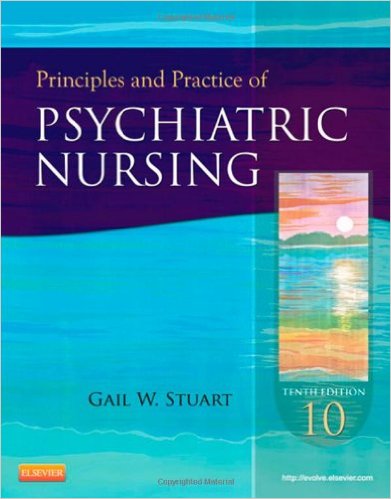Description
Principles And Practice of Psychiatric Nursing,10th Edition by Gail Wiscarz Stuart -Test Bank
Chapter 5: Biological Context of Psychiatric Nursing Care
Test Bank
MULTIPLE CHOICE
1. When a patient asks the nurse, “What are neurotransmitters?” The nurse replies that neurotransmitters are:
|
a. |
“the chemical messengers that cause brain cells to turn on or off.” |
|
b. |
“small clumps of cells that alert the other brain cells to receive messages.” |
|
c. |
“tiny areas of the brain that are responsible for controlling our emotions.” |
|
d. |
“weblike structures that provide connections among various parts of the brain.” |
ANS: A
Neurotransmitters are chemicals manufactured in the brain responsible for exciting or inhibiting brain cells in the production of an action.
DIF:Cognitive Level: ComprehensionREF:Text Page: 73
TOP:Nursing Process: Implementation
MSC:NCLEX: Physiological Integrity: Physiological Adaptation
2. A patient tells a nurse, “My doctor says my problem may be with the neurotransmitters in my brain but I don’t understand what that means.” The nurse responds:
|
a. |
“Let’s begin with exploring what your doctor has told you about your problem.” |
|
b. |
“We should start with a discussion about any concerns you have about having a neurotransmitter disorder.” |
|
c. |
“First let me say that neurotransmitter problems can usually be treated or cured with medication therapy.” |
|
d. |
“What you need to understand is that neurotransmitters are chemical messengers in the brain responsible for brain communication.” |
ANS: A
The correct option assesses the patient’s understanding of his condition, the initial step in any educationally focused discussion. None of the remaining options—defining the role of a neurotransmitter, exploring the patient’s concerns, or providing an explanation of a typical treatment plan—address the patient’s question concerning a lack of understanding.
DIF:Cognitive Level: ComprehensionREF:Text Page: 73
TOP:Nursing Process: Implementation
MSC:NCLEX: Physiological Integrity: Physiological Adaptation
3. Which part of the brain is responsible for fine motor coordination?
|
a. |
Medulla |
|
b. |
Thalamus |
|
c. |
Cerebellum |
|
d. |
Temporal lobe |
ANS: C
The cerebellum is responsible for fine motor coordination, posture, balance, and integration of emotional processes.
DIF:Cognitive Level: KnowledgeREF:Text Pages: 73-74
TOP:Nursing Process: Assessment
MSC:NCLEX: Physiological Integrity: Physiological Adaptation
4. Which neurotransmitter is located only in the brain, particularly in the raphe nuclei of the brainstem, and is implicated in depression?
|
a. |
Norepinephrine |
|
b. |
Acetylcholine |
|
c. |
Dopamine |
|
d. |
Serotonin |
ANS: D
Serotonin, also called 5-HT, is derived from tryptophan, a dietary amino acid. It is located only in the brain, particularly in the raphe nuclei of the brainstem. It plays a role in regulation of mood through its mood-elevating capacity.
DIF:Cognitive Level: ComprehensionREF:Text Page: 76
TOP:Nursing Process: Assessment
MSC:NCLEX: Physiological Integrity: Physiological Adaptation
5. What part of the brain is responsible for regulating pituitary hormones and is known to regulate the body’s temperature?
|
a. |
Thalamus |
|
b. |
Cerebellum |
|
c. |
Limbic system |
|
d. |
Hypothalamus |
ANS: D
The hypothalamus is responsible for regulation of metabolism, temperature, and emotions.
DIF:Cognitive Level: KnowledgeREF:Text Page: 73
TOP:Nursing Process: Assessment
MSC:NCLEX: Physiological Integrity: Physiological Adaptation
6. Which neurotransmitter is involved in the movement disorders seen in Parkinson disease and in the deficits seen in schizophrenia and other psychoses?
|
a. |
Dopamine |
|
b. |
Melatonin |
|
c. |
Serotonin |
|
d. |
Norepinephrine |
ANS: A
Dopamine is derived from tyrosine, is located mostly in the brainstem, and is involved in control of complex movements, motivation, and cognition. It is involved in movement disorders such as Parkinson disease and in many of the deficits seen in schizophrenia and other forms of psychosis. This is not necessarily true of the other options.
DIF:Cognitive Level: KnowledgeREF:Text Page: 76
TOP:Nursing Process: Assessment
MSC:NCLEX: Physiological Integrity: Physiological Adaptation
7. A nurse explains to a patient undergoing diagnostic testing which brain imaging technique measures brain structure?
|
a. |
Computed tomography (CT) |
|
b. |
Positron emission tomography (PET) |
|
c. |
Brain electrical activity mapping (BEAM) |
|
d. |
Single-photon emission computed tomography (SPECT) |
ANS: A
CT can image brain structures through a series of radiographs that are computer-constructed into “slices” of the brain that can be stacked by the computer, giving the image a three-dimensional appearance. PET and SPECT image brain activity and function through the tracking of radioactive substances as they travel through the brain. BEAM images brain activity and function through recordings of the brain’s electrical activity.
DIF: Cognitive Level: ComprehensionREF: Text Pages: 74-77
TOP: Nursing Process: Assessment
MSC:NCLEX: Physiological Integrity: Physiological Adaptation

Reviews
There are no reviews yet.